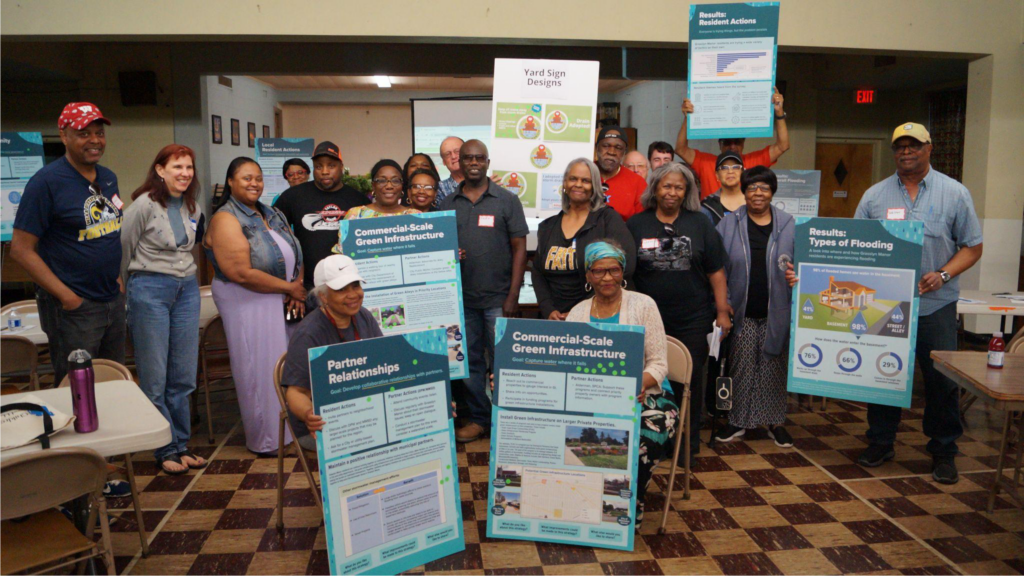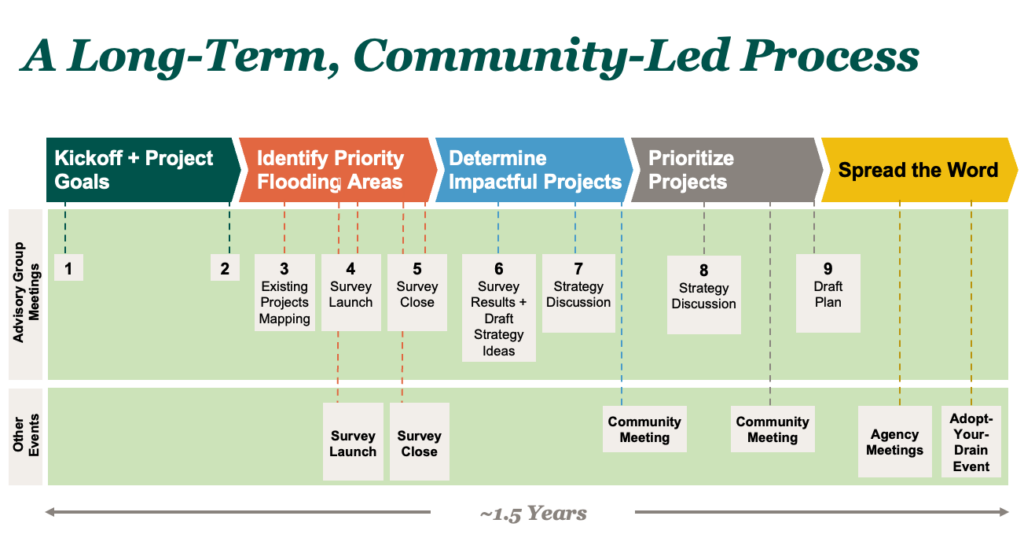View the original recording of the webinar, recorded July 22, 2025, on the Environmental Finance Center Network’s YouTube channel.
When basement flooding became a recurring nightmare for residents in Milwaukee’s Grasslyn Manor neighborhood, they could have simply accepted it as an inevitable part of life. Instead, they did something remarkable: they organized, engaged with technical experts and built partnerships that transformed not just their infrastructure, but their entire community.
Greenprint’s Director of Planning, Sydney VanKuren, is joined by Grasslyn Manor Resident Leader Steve O’Connell in a recent Environmental Finance Center Network webinar. They shared the inspiring story of how residents in this Milwaukee neighborhood turned their flooding crisis into a model for community-driven infrastructure solutions.
The Challenge: More Than Just Water in Basements
The problems in Grasslyn Manor ran deeper than soggy carpets and damaged belongings. Located near natural springs and former swamplands that were developed into commercial properties, the neighborhood faced complex stormwater issues. In a resident survey conducted by the Help Build the Ark Advisory Committee (a group of resident advisors formed during this project), a whopping 96% of residents indicated that they had experienced basement flooding.
But perhaps the bigger challenge was isolation. As resident leader Steve O’Connell explained, “So many of our residents just felt it was their problem [to solve]. When these major water events would happen, they’d just cover it with bleach, remove the carpet, and not talk to each other about it.”
This isolation was compounded by a trust gap between residents and government agencies — a challenge that 52% of webinar attendees identified as one of their top barriers to meaningful community engagement between residents and city officials.

Credit Michael Timm.
Building Momentum: Moving at the Speed of Trust
The transformation began when residents connected with Greenprint Partners, an environmental consulting firm specializing in nature-based solutions. Rather than arriving with predetermined solutions, Greenprint committed to what they called “moving at the speed of trust” — a long-term process guided by community needs and timelines, and funded by Builders Initiative.
VanKuren emphasized their approach: “We weren’t coming with infrastructure construction dollars to do a particular project. We wanted to capture voices and see what might be possible together as a way of bringing everyone to the table.”
This patient approach paid dividends. What started as a 10-person advisory committee grew to 15 active members, including the local alderman, as momentum built throughout the 1.5-year collaborative process.
Replicable Processes and Lessons Learned
The Grasslyn Manor experience offers valuable strategies that other communities can adapt:
Start with community-led data gathering. Rather than relying on outside experts to assess problems, residents conducted door-to-door surveys themselves. Of 217 homes, they gathered 53 responses — with many more residents sharing information off-the-record due to insurance concerns. The key insight: neighbors trusted neighbors more than government officials.
Use shared data to break down isolation. When residents saw survey results at community meetings, everything changed. Suddenly, neighbors realized they weren’t alone — 96% of respondents had experienced basement flooding. This shared understanding sparked peer-to-peer problem-solving conversations.
Compensate community expertise. Greenprint provided stipends to advisory group participants, recognizing that community members bring valuable knowledge and time to the table. This respect for residents’ contributions helped build genuine partnership.
Create quick wins while building toward larger solutions. The collaboration produced immediate, tangible benefits:
- A resident handbook on managing flooding (230 copies printed and distributed)
- Refrigerator magnets with city reporting numbers and safety warnings
- An “Adopt-Your-Drain ” campaign that dramatically improved neighborhood drainage maintenance
- Early warning systems through the WaterMarks program that alert residents to impending flood events
Provide technical translation and advocacy support. According to O’Connell, having Greenprint engineer Hannah Kacprzak at meetings changed the dynamic with city officials. He noted, “It wasn’t the energetic guy coming to the city and complaining [in reference to himself] … we had people who could speak to [technical] solutions and they would address Hannah directly.”
Move at the community’s pace. Spend significant time listening and understanding community experiences before proposing solutions. Create multiple engagement pathways — not everyone can attend evening meetings, so provide flexible participation methods, including printed and digital materials and door-to-door engagement.

Measurable Outcomes and Ongoing Impact
The community-driven approach yielded concrete results:
- Two green alleys were constructed in their neighborhood, with residents documenting the entire process
- The City, in partnership with the Milwaukee Metropolitan Sewerage District (MMSD), initiated a Private Property Inflow and Infiltration (PPII) program, which pays for updated laterals and sump pumps
- Monthly meetings now include the City of Milwaukee’s Department of Public Works and MMSD representatives
- A green schoolyard project is underway at 53rd Street neighborhood school
Perhaps most importantly, some residents reported to O’Connell that drain cleaning and proactive maintenance (as recommended by the handbook) prevented basement flooding in their homes last summer. The story of Grasslyn Manor proves that when communities are genuinely empowered to lead, they can transform both their infrastructure and their relationships with the systems meant to serve them.
